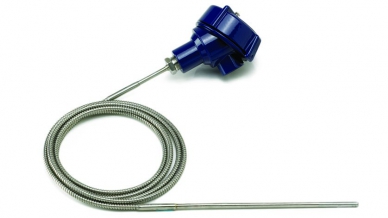
WIKA measuring instruments are found in waste-to-energy facilities around the world, helping these modern waste-disposal and power plants operate more safely, efficiently, and sustainably.
This article is a continuation of “From Waste to Watts: Making the Case for Energy Recovery Plants.”
Measuring Instruments for EfW Power Stations
Measuring instruments ensure the safety and efficiency of energy-from-waste plants. It goes without saying that those gauges, sensors, switches, and transmitters must be able to withstand high pressures (up to 500 psi) and extreme temperatures:
- Primary combustion chamber – 1,400°F (760°C)
- Secondary combustion chamber – 1,600°F (870°C)
- Steam boilers – 600°F (315°C)
- Flue – at least 1,480°F (805°C) for more than 2 seconds to convert NOX to N2
- Steam turbine – 500°F (260°C)
Solutions for temperature monitoring and control
Both thermocouples and RTDs are suitable for WtE facilities. The choice of sensors depends on several factors:
- The application’s temperature range
- The application’s pressure range
- Mechanical vibration and shock
- The medium’s characteristics (solid/liquid/gaseous, corrosive, hazardous) and flow rate
- Space constraints
- Accuracy, repeatability, and stability
- Response time

TR10 RTD sensor
Temperature indicators (TI) are located along the fireproof ceiling, walls, and base of combustion chambers, totaling 12 to 16 sensors. Temperature transmitters, housed in control cabinets away from high heat conditions, are connected to each TI via a compensating line to minimize signal loss.
Two of the core products found in waste-to-energy plants are WIKA’s TR10-2 RTD assembly and TC10-2 thermocouple assembly. Designed to be mounted inside a thermowell, these spring-loaded industrial temperature sensors ensure good contact with the base of a thermowell bore for high accuracy and a fast response time.
When an application requires the fastest response time, use a sensor that can be installed directly into the process without a thermowell. WIKA’s TR10-3 RTD assembly and TC10-3 thermocouple assembly have high ingress protection and explosion-proof electrical approvals for hazardous locations. Both models are configurable with an extensive range of connection heads, terminal blocks or transmitters, neck lengths, insertion lengths, and more. An optional compression fitting makes it easy to adjust the insertion depth during installation. The metal sheath of the TC10-3 offers excellent protection against the chlorides, hydrochloric acids, and high temperatures found in an incinerator’s combustion chambers.

TR15-2 industrial RTD assembly
Sometimes the best way to protect temperature sensors is to relocate them away from the high-heat or high-vibration environment. The TR15-2 RTD assembly and TC15-2 thermocouple assembly are WIKA’s remote-mount models. In addition, they protect human lives by allowing operators to install, maintain, and repair the instruments at a safe distance. Furthermore, the TR15-2 and TC15-2 are ideal when a location makes direct mounting difficult or impossible.

T38 temperature transmitter
These industrial temperature assemblies come with or without a temperature transmitter. For sensors that require one, use the universally programmable T38 digital transmitter. It offers high accuracy through sensor–transmitter matching, the highest reliability, and excellent protection against electromagnetic influences. Via HART® protocol, the T38 temperature transmitter is configurable (interoperable) with a variety of open configuration tools. Through the configuration of a sensor with redundancy (dual sensor), it will automatically change over from the failed sensor to the backup sensor. Furthermore, with WIKA True Drift Detection technology, the T38 allows operators to continuously monitor sensors for temperature drift and immediately identify erroneous measuring locations.
Other quality temperature instruments for power stations:
- TG51 bimetal thermometer, process version per ASME B40.200 – for temperature measurement in furnaces, steam generators, and the utilities section of a plant.
- TR53 bayonet RTD and TR58 bearing RTD sensor – used to measure the temperature of cylinder heads, an engine’s oil sumps, lube oil systems, and bearings in rotating equipment.
- TC8X thermocouple – designed for use in extremely high temperatures (up to 2,912°F/1,600°C) with a high-purity ceramic inner tube and oxidation-/corrosion-resistant metals. The pure ceramic insulators and tubes, in conjunction with thermocouples made of noble metals, provides excellent resistance against contamination and premature degradation.

233.54 pressure gauge
Solutions for pressure monitoring and control
To produce electricity, a waste-to-energy plant heats water in a utility boiler to produce the high-pressure steam needed to spin the turbine’s blades. Process gauges and pressure transmitters monitor and control this process. Since rotors and bearings produce significant mechanical vibration during operation, and are found in high-temperature environments, the pressure instruments on steam turbines must be able to withstand these two common reasons for gauge failure.
Liquid case fill is an easy and cost-effective way to prolong a mechanical gauge’s service life. The glycerin or silicone oil dampens and slows the movement, which reduces wear and tear on the internal mechanisms. A liquid-filled gauge is also easier to read in high-vibration applications than a dry gauge.
A popular pressure instrument for steam turbines is the 233.54 Bourdon tube pressure gauge with all-stainless steel construction and liquid-filled case. For extra safety, durability, and unimpaired reading (no air bubbles in the case filling), choose FlexWindow™, a clear disk made of liquid silicone rubber (LSR) that takes the place of laminated safety glass.

CPG1500 digital pressure gauge
Another option is to use one of our SealGauge™ diaphragm pressure gauges. With a metal diaphragm as the sensing element, liquid-filled SealGauges are better able to withstand mechanical vibrations than even liquid-filled Bourdon gauges. What’s more. WIKA not only designs and manufactures diaphragm seals in the U.S., but we offer fast service on diaphragm seal systems. By replacing the worn diaphragm seal, pressure gauge, or other wetted parts, we save our customers significant time and money compared to replacing the entire unit.
With the pneumatic kit or hydraulic kit, the CPG1500 precision digital pressure gauge is ideal for onsite calibration. On its own, the CPG1500 can be used throughout the plant as a single-channel datalogger for pressure, and also for remote monitoring and diagnostics of process piping as well as various equipment and machinery.
Design for the process industry, the DPGT43HP differential pressure gauge with output signal is found in locations with a high differential pressure overload and/or high working pressures (static pressures). It is made of high-quality stainless steel for reliable measuring in aggressive environments across primary flow elements, such as for steam service or on scrubber lines.

BNA bypass level indicator
Both the A-10 and S-20 pressure transmitters are compact instruments used for monitoring pressure throughout a WtE plant, especially in rotating equipment with tight spaces. Their analog output signals include 4 … 20 mA, DC 0 … 10 V, DC 1 … 5 V, and others upon request.
Solutions for level measurement
Whether a power plant uses solid municipal waste, fossil fuels, or another energy source, its industrial boiler converts water into the high-pressure steam that turns the blades of a turbine to generate electricity. To ensure that the boiler system always has a sufficient level of water, the steam drum is generally equipped with three level gauges (for extra redundancy0, and sometimes in conjunction with a float level switch.
WIKA’s MODEL BNA bypass level indicator continuously monitors tank levels without a power supply. Its simple yet elegant design features a float magnet that moves freely inside a bypass chamber as the liquid level rises and falls. Operators can easily discern the liquid level, thanks to the BNA’s large color-coded display. A wide selection of flanges and materials offers solid process connections for any process condition. For remote monitoring and automated control, mount the BNA with a level transmitter or float switch.
Solutions for flow measurement

Flow nozzle for flange assembly
EfW facilities rely on a system of pipes to carry water and steam to and from various points. To ensure safety and efficiency, Venturi nozzles and flow nozzles monitor the fluids’ rate to make sure that the flow is within acceptable ranges. These primary flow elements are available in all standard nominal sizes, measure fluid flow rates with minimal pressure loss, and have an accuracy within ≤ ±1.0% of the actual flow rate. With calibration, an accuracy as high as ±0.25% can be achieved.
The final article of this three-part series continues next week with a case study about how WIKA helped a WtE plant find temperature sensors that withstand the corrosive environment of its incineration chamber.
Products mentioned in this article:
• TR10-2 RTD assembly
• TC10-2 thermocouple assembly
• TR10-3 RTD assembly
• TC10-3 thermocouple assembly
• TR15-2 RTD assembly
• TC15-2 thermocouple assembly
• T38 digital transmitter
• TG51 bimetal thermometer
• TR53 bayonet RTD
• TR58 bearing RTD sensor
• TC8X thermocouple
• 233.54 Bourdon tube pressure gauge
• CPG1500 precision digital pressure gauge
• DPGT43HP differential pressure gauge with output signal
• A-10 pressure transmitter
• S-20 pressure transmitters
• BNA bypass level indicator

